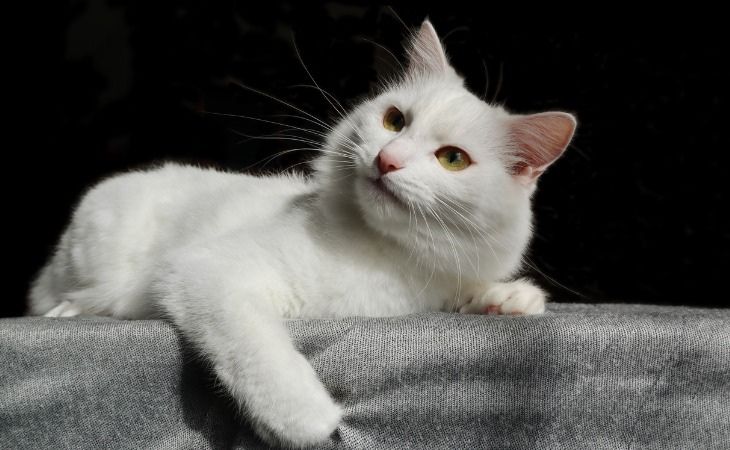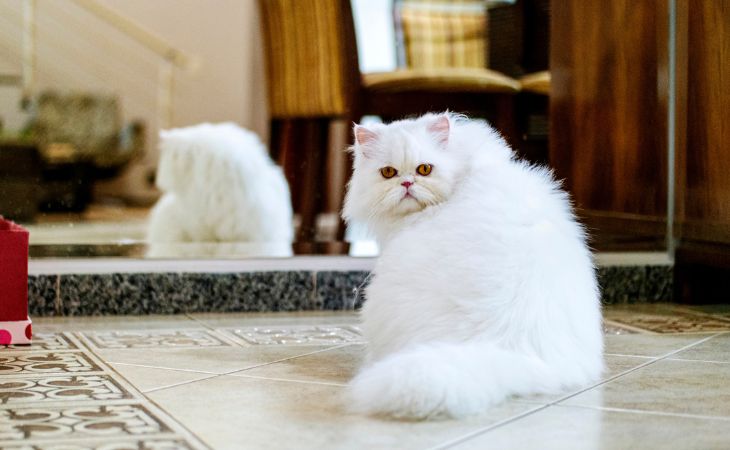The Persian cat is the descendant of the Turkish Angora. Explorers helped to spread the Persian cat breed by bringing these cats to Europe during the 17th century. The Turkish Angora and the Persian cat are two of the oldest cat breeds in the world.
The Persian cat and the Turkish Angora: size and main physical characteristics
The Turkish Angora and the Persian cat differ in a few ways when it comes to their physical characteristics.
The Persian cat, a robust feline
Persian cats can be medium to large cats. They have a developed musculature underneath their thick coat. The Persian cat has large eyes that contrast its small ears and flat nose. When it comes to the color of its coat, the Persian cat can have up to three colors maximum.
The Turkish Angora, athletic and delicate
Unlike the Persian cat, the Turkish Angora has a coat that is less dense, but a tail that is more bushy. The particularity of the Turkish Angora is its eyes, which are predominantly blue. The Turkish Angora’s coat is dominantly white, which is very common in pure breeds. Of course, other colors are still possible. However, they are not recorded or recognized as the standard of the Turkish Angora breed.
Behavior
The Turkish Angora and the Persian cat are relatively calm cats.
Calm cats
The word “calm” perfectly describe these cats. As the Persian cat is gentle and very affectionate, it is not a very adventurous cat. This cat truly enjoys spending time with its owner and is very dependent on its owner’s affection. With that being said, this cat breed is very sociable, and would live happily with a family with children. When it comes to the Turkish Angora, this cat breed is also known for being calm and comforting.
Just like its descendant, the Persian cat, the Turkish Angora enjoys spending time with its owner and appreciates the comfort of a couch or bed. There is, however, a big difference between the Persian cat and the Turkish Angora. The latter is more independent and is more proud. For this reason, this cat needs more attention. Unlike the Persian cat, the Turkish Angora knows how to make it clear that it has had enough and does not hesitate to walk away.
Intellectual stimulation
Turkish Angoras enjoy games that stimulate their cognitive reflexes. They are receptive when it comes to training them to do certain things like bring back a toy that you threw. Do not hesitate to invest in a cat tree to not only allow your cat to stimulate their senses, but also keep their claws in good shape.
The Persian cat is less interested in toys and physical activity in general. These cats are truly indoor cats. They would rather rest and lie down on your lap. Persian cats are also considered lazy cats.
Food
For the well-being of these cats, it is important to make sure to choose the right food for them.
What food should you give to these cat breeds?
The meals of Persian cats need to be watched because these cats tend to gain weight. Do not hesitate to give your Persian cat specific food to guarantee that they are eating healthy and good quality meals. The Turkish Angora, who has a more delicate palate, will be more exigent when it comes to their meals and will want meals that are better quality, composed of large rations of meat. Unlike the Persian cat, the Turkish Angora has no predisposition to obesity. Keep an eye on their balance, because do not forget that the Turkish Angora is also a lazy cat.
Carefully follow your pet’s development cycle
Whether you have a Persian cat or a Turkish Angora, these cats do not eat in the same way, especially when it comes to kittens, adult cats, or senior cats. Kittens need a lot of protein, as the goal is to promote the development of their musculature and their immune defenses.
For an adult cat, opt for a classic meal. In any case, it is highly recommended to accompany their food evolution by making progressive changes. First, mix a small amount of adult cat food with their daily ration. Analyze how it goes, then repeat the test day after day, by augmenting little by little the new ration compared to the old one. For senior cats, the transition is less complicated. Senior cats are already used to food for adult cats. The change for these cases will be mainly in the composition of the food, which will often have to be adapted to the possible diseases that they have developed with age.

Caring for Turkish Angoras and Persian cats
To take care of your cat, you need to keep an eye on their health.
Coat
Like many cat breeds, Turkish Angoras take care of their coat by themselves by grooming themselves regularly. Despite this, it is necessary to brush them regularly to keep their coat being beautiful and soft. Turkish Angoras have very full and long coats. To limit the creation of knots, get your cat used to having their coat brushed 1 to 2 times per week. If despite all this, their coat gets tangled, cut the fur delicately so that it grows better. Keep in mind that the Turkish Angora molts in the spring and the autumn. During these periods, you should brush them regularly. Keeping your Turkish Angora’s coat in good condition is very important.
If their coat is not taken care of well, the skin will have a harder time breathing under the large amount of fur and can lead to inflammations, or even mycosis. When it comes to Persian cats, they need their coat to be taken care of daily. As their coat is denser and thicker than the Turkish Angora, the fur of Persian cats has a tendency to get tangled easily. One of the biggest inconveniences is the fur balls that these cats throw up, which is very uncomfortable for them. Lastly, if you want to wash your cat or untangle their coat, we recommend that you should specific dry shampoos. This is applicable both for Persian cats and Turkish Angoras.
Lifestyle
Persian cats need their humans to be around them a lot daily. If you are rarely at the house or not very available, the Persian cat is not for you. While cats are generally more autonomous than dogs, some cats like Persian cats require a lot of attention.
They will quickly get bored when you aren’t there and their social needs would not be fulfilled. The Turkish Angora also needs its owner to be home a lot so that it can blossom and live happily. A bit more independent than the Persian cat, but still in need of constant socialization, the Turkish Angora needs your presence for physical and intellectual activities. They can, of course, do these activities alone, but it will not be enough for their social and cognitive needs. If you are not able to give your cat the attention that they deserve, it is best to reconsider adopting a Turkish Angora.
Specific diseases
The risk of obesity is the burden of the Persian cat, during all their life. It is, therefore, necessary to pay close attention to your cat’s weight. In addition, this cat’s eyes are also fragile, which can cause their eyes to have frequent discharges. Make sure to clean your Persian cat’s eyes regularly to limit the risk of infection.
Let us now evoke the so-called “old age” diseases, which are polycystic kidney disease and progressive retinal atrophy. The first of these diseases is a hereditary disease, affecting the renal function, which may lead to liver failure. When it comes to retinal atrophy, this leads to progressive blindness. However, it is neither rare nor worrying for a cat to develop age-related illnesses. Even though these must be monitored, they do not present a major handicap for your feline, which is not the case with polycystic fibrosis.
The Turkish Angora has a tendency to be impacted by auditory illnesses, notably odd-eyed Turkish Angoras who are characterized by the color of their eyes (one blue, one yellow). While it may look cute, this particularity is unfortunately very often revelator of a genetic auditory anomaly. You can anticipate this illnesss by having the two parents tested by the vet. Be careful also of the significant hearing loss to which white-coated cats are prone. They can develop deafness.

